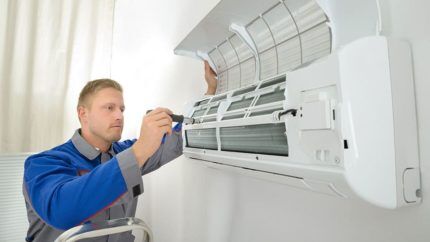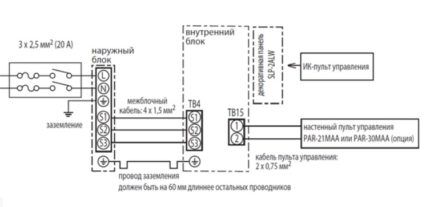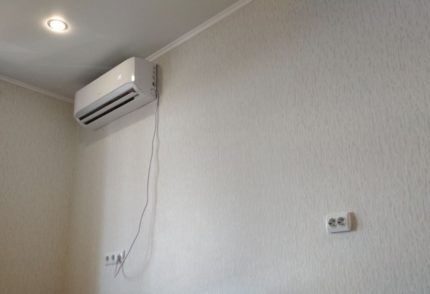How to connect an air conditioner to the network with your own hands: order of cable routing + step-by-step instructions for connecting the indoor and outdoor units
Air conditioning is one of the most popular types of equipment in the hot season, which is widely used in private homes, offices and apartments. High-tech equipment provides optimal microclimatic conditions indoors for work, exercise or relaxation.
Installation and subsequent launch of air conditioning systems are quite complex processes, don’t you agree? But if you understand the diagram, you can try to install and connect the equipment yourself.
In this article we will talk about how to connect an air conditioner to the network and what tools are required for this. We will also describe in detail the connection steps and requirements for the electrical network. To make it easier to understand, we will supplement the material with visual photos and videos.
The content of the article:
Briefly about the operating principle of the equipment
Modern devices for maintaining an optimal indoor microclimate will help make life more comfortable and also protect the body from harmful external influences.
Climate control equipment is divided by area of use - industrial, semi-industrial and household. Depending on the type of installation, there are stationary And mobile models.
Depending on the type of design, air conditioners are floor-shelf, wall-mounted, floor, cassette, columnar, channel, window.
The principle of their operation is based on a change in the state of aggregation of freon depending on pressure and temperature in a closed system. The devices do not produce heat and cold on their own, but only transfer it, depending on the selected mode - from indoors to outdoors or vice versa.

Stages of connecting the air conditioner to the network
Connecting the air conditioner to the network is an equally important stage that comes after selecting, purchasing and installing climate control equipment.
All work must be carried out in accordance with the diagrams given in the installation and operating instructions. The circuits are also shown on the covers of the external and internal modules.
Stage #1 - preparing tools and materials
Connecting the air conditioner to the network, like any electrical installation work, is carried out using tools, including a drill, pliers, a set of screwdrivers and more.
Mandatory consumables include screws, dowels, clamps, a plastic box for cables, etc.

The exact list of required materials and tools depends on several factors:
- device models;
- air conditioner manufacturer's requirements;
- the selected method of connecting to the network (via a socket or via a separate power line).
Particular attention should also be paid to the equipment on which the stability of the device depends. So, if you regularly notice power surges in the network, you should immediately select stabilizer for home.
To connect the air conditioner to the power supply network, you will need a socket, a wire and a circuit breaker.
To calculate the required wire length, you will need to consider:
- wall thickness;
- distance from the wall to the outdoor and to the indoor unit;
- cable length under the modules themselves (approximately 1.2 - 1.5 m).
It is also advisable to provide an additional cable so that you can connect sensors, for example, temperature ones.
The wire cross-section is selected taking into account the manufacturer's recommendations. The installation manual provides electrical connection diagrams for a specific model.

Fastening the wiring when laying communications using ducts is done using screws and glue. For so-called hidden wiring, you will also need special clamps with which to secure the cables in the grooves.
Special construction plaster is used to finish the walls. This material allows you to quickly open the plastered layer if necessary.
Stage #2 - studying network connection diagrams
It is important to ensure reliable grounding of the air conditioner - new houses have a grounding conductor.But with old housing stock, everything is not so simple - they do not have “ground”, so most users turn on the equipment “as is”.
To protect against network overload, a circuit breaker is installed in the electrical panel on an individual line. Detailed information is provided in the technical documentation with step-by-step actions when connecting climate control equipment. By following them, you can do the work on your own.
Also, under the cover of the outdoor unit of the split system, there is a diagram of how to correctly connect the wires to the outdoor and indoor units of the air conditioner, and connecting the latter to the power supply network.

Stage #3 - connecting blocks via cable
To connect the blocks to each other, it is necessary to lay an interblock wire from the internal module to the external one. This is done together with laying the freon line. We recommend that you read the manual laying the air conditioner route.
Another wire will be needed to connect the indoor unit to a separate power line.

To make connections you have to strip wires of insulation. This can be done using a regular knife or a special tool for stripping from cables and wires.
Connection of the external and internal air conditioner units is carried out according to the following diagram:
- it is necessary to remove the front decorative panel or protective cover of the unit;
- stretch the cable and place it on the side of the module;
- strip the ends of the wires;
- insert them into the appropriate terminals and secure;
- secure the cable at the outlet of the unit;
- close the module with a lid.
In some air conditioner models, a separate wire for the temperature sensor is laid between the units.
Stage #4 - connecting the device to the network
The electrical circuit for connecting devices in everyday life is radically different for semi-industrial models installed in office premises.
In practice, two main methods are used:
- through a socket;
- with separate wiring and connection of the air conditioner wire to the electrical panel.
The first option is used to commission almost all household devices.
If you decide to connect the air conditioner using a standard socket, this can only be done in certain situations:
- The air conditioner power is low;
- the electrical network in an apartment or private house has sufficient power;
- the device will be located in this part of the room temporarily.
It must be taken into account that it is prohibited to connect other household devices to the line.

If the outlet does not meet the parameters specified by the manufacturer, the only way out of the situation is to lay a separate line from the panel to the indoor unit of the air conditioner.Connecting via an individual cable is a safer and more reliable way to ensure stable operation of the equipment.
Installation automatic machine for air conditioner will protect against network overload and possible fire. In addition, thanks to individual cable routing for air conditioners, the modules can be placed anywhere.
Stage #5 - checking the operation of the modules
After connecting the blocks, you need to check the correctness of the work performed, then test the assembled circuit by briefly starting the system.
Before checking the operation of the air conditioner and starting it for the first time, you should determine height differences between blocks. Manufacturer's recommendations are indicated in the instructions for the equipment.
Correct installation outdoor unit can be determined by several parameters:
- The outdoor unit vibrates during operation, so the wall for mounting it must be level and strong.
- The block is installed by level.
- The distance between the wall and the module itself should be 10 cm, otherwise the block may overheat at high temperatures in summer.
- The brackets must be attached to anchor bolts.
To protect the outdoor unit from ice and precipitation, install visor.

The maximum permissible distance between blocks is three meters. Each model may have its own recommendations; you can check them with the instructions.
Be sure to check the fastening of the copper routes. The tubes must be secured, otherwise it is difficult to guarantee their functionality.
For effective condensate drainage the drainage pipe must be at an angle.
Conclusions and useful video on the topic
The connection diagram for the air conditioner to the network is discussed in detail in the following story:
Tips for laying cables can be found in the video:
The installation and subsequent connection of the air conditioner is briefly described in the video:
Having the skills to perform electrical installation work, you can connect the air conditioner units to the network on your own. A trial and short-term switching-on is carried out after completing the connection of the modules, checking with the diagram, checking the connection and power supply of the external and internal units of the air conditioner.
Electricity does not forgive inaccuracies and mistakes. Before connecting yourself, you should adequately assess your own skills. If you do not know how to properly connect the air conditioner, then you should invite an electrician, otherwise independent attempts may end in the repair of expensive equipment, electric shock or fire.
If you have experience connecting an air conditioning system, please share your story. A section for comments and questions is located below this post.



